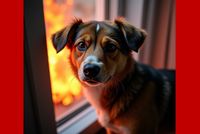Protecting your pets or livestock requires knowledge and preparation, not just good intentions.
Every second counts. Be prepared. Be the rescue.
When flames rise, waters surge, or an earthquake shakes the region and the danger grows, our animals depend on our composure, but also on our preventive preparation.
In the hour of crisis, every decision matters and every pre-planned measure can save lives.
A clear plan, calm leadership and decisive action preserve trust, security, and the invaluable invisible bond that connects us to our beloved pets and livestock.
So be well prepared, because animals are particularly vulnerable in natural disasters, thoughtful emergency measures determine life and safety.
General Immediate Measures
Securing and Locating Pets
- Bring all pets indoors or to a safe, sheltered location.
- Prevent panic — calm words and a familiar environment can help.
- If evacuation is necessary, keep sturdy transport crates ready.
Don't forget to prepare an emergency kit.
A well-organized emergency bag should ideally include
- Transport equipment: sturdy leashes, harnesses, stable transport crates.
- Health care: medications, copies of medical records in a waterproof container.
- First aid kit: disinfectants, bandages, tweezers for removing debris.
- Identification: recent photos of you with your pet for easy recognition.
- Food supply: enough food and water for at least 72 hours.
- Important contact information: details of your veterinarian and local rescue services.
Evacuation and Safe Escape Routes
- Practice evacuation scenarios with your animals so they become familiar with transport crates and safety measures.
- If your pet is prone to panic, train calming techniques and create a secure environment.
- Ensure regular health check-ups for your pet to maintain physical resilience.
- Stay informed about warning alerts so you can react immediately.
- Prepare in advance a list of emergency shelters for animals (animal shelters, hotels, friends/acquaintances, farms).
- If a quick evacuation is necessary, have sturdy transport options for your pet ready.
- Keep medications and first aid supplies handy for respiratory and skin issues.
- For livestock, establish a clear evacuation plan with transport vehicles and gathering points. If immediate transport and rescue are not possible, barns should be opened to allow self-rescue.
Specific Measures for Fire/Wildfire – Prevention Against Heat & Flying Embers
- Keep animals away from smoke sources, as smoke inhalation is a serious risk for them.
- Lightly moisten fur or feathers to protect them from flying embers. Damp cloths or light mist sprays can help cool and shield the fur.
- Ensure an ample supply of water for your pet to prevent dehydration.
- Avoid overheated or burned surfaces as they can injure paws.
- If evacuation is necessary, follow official warnings and leave hazardous areas early.
First Aid After Smoke or Heat Exposure
- Observe animals for symptoms such as coughing, labored breathing, lethargy, or watery eyes. If your pet coughs, breathes heavily, or appears disoriented, seek veterinary help immediately (if possible in this situation).
- If your pet appears overheated, place a damp towel on its body (not ice-cold, to avoid temperature shock).
- Watch for delayed symptoms, as reactions may not appear immediately.
- Keep your pet in a well-ventilated area to improve breathing.
- After returning to a safe environment, clean fur and paws from soot and ash, and check paws for burns or blisters. Cool paws with lukewarm water and keep them clean to prevent infections. If visible burns are present, do not touch them directly — gently cover them with a damp, sterile cloth and seek veterinary care.
Specific Measures for Floods
- Move your pets and smaller livestock to higher ground.
- Avoid flooded areas as much as possible, as animals can be injured by strong currents.
- Keep food supplies waterproof to prevent spoilage.
Fire can be extremely frightening for animals, but with calmness and targeted actions
- Please Stay calm: pets sense our emotions. A steady voice and gentle movements help prevent them from panicking.
- Create a familiar environment: if possible, keep them in their transport carrier or a space with familiar blankets and toys.
- Gentle touch and reassurance: stroking and soothing words help reduce their stress.
- Distraction through food or treats: sometimes, a small reward helps redirect their focus away from danger.
- Protection from noise and smoke: a damp cloth can help shield against smoke, and a quiet, darkened space can have a calming effect.
- Routine escape routes: if you practice evacuation drills in advance, your pet will be less panicked in a real emergency.
- Monitor your pet’s behavior for several days after the event, watching for fatigue, loss of appetite or other unusual symptoms. A calm environment helps them recover faster.
Never forget — your pets and livestock trust you and your calm and professional actions are their best refuge!
This contribution was written by Birgit Bortoluzzi, the creative founder of the “University of Hope” – an independent knowledge platform with a mission: to make resilience, education, and compassion visible and audible in a complex world.
